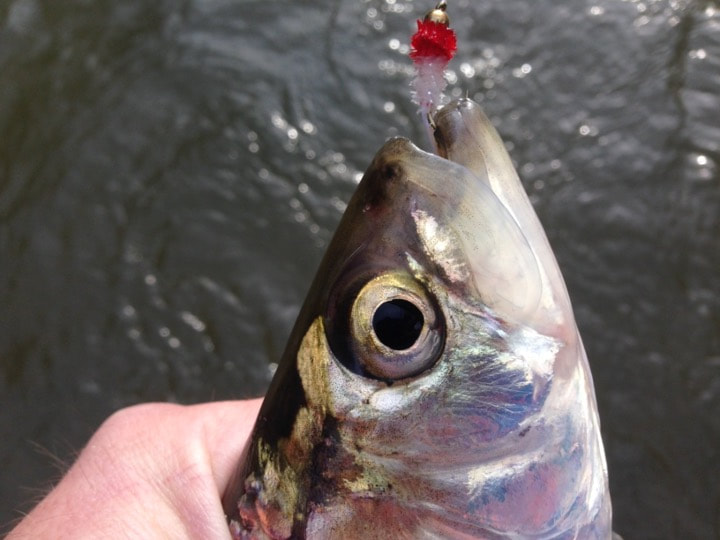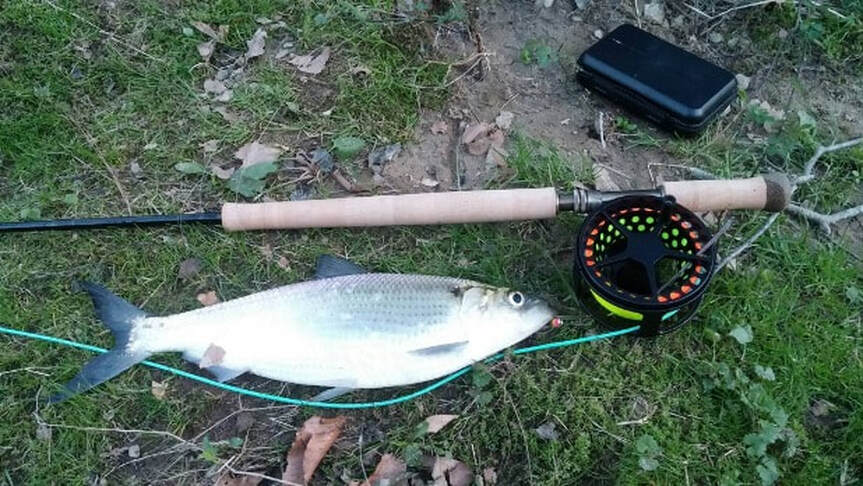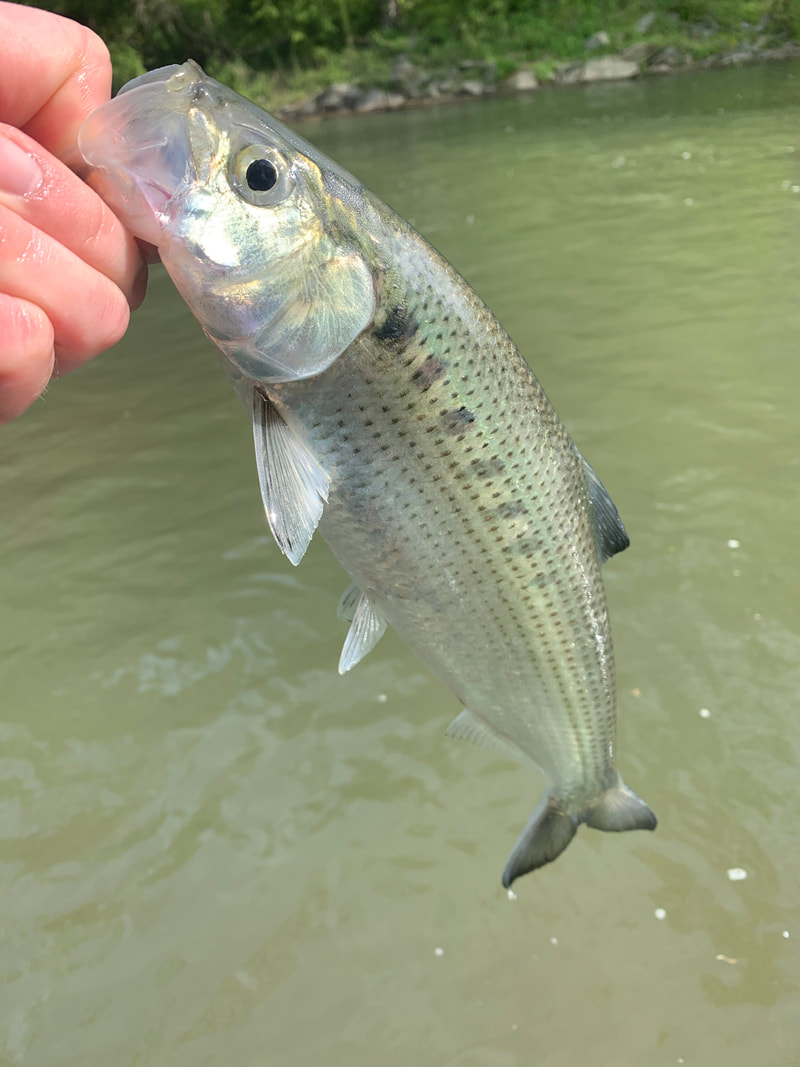By Tim O'NeillThe spring Shad run can be one of the most prolific fisheries of the spring, it can also be one of the most overlooked. Starting at around mid-April our rivers and tributaries will fill with these migrating fish as they start their yearly pilgrimage to span and repeat the circle of life. A quick circle it is as the entire spawn lasts around 6 weeks. If it is past the third week of May and I have 2 subpar outings, a sub-par outing is less than 30 fish, it is time to move on to Smallmouth. What is a good outing you may ask… on a year with a strong migration, when targeting hickories, triple digit catch numbers is the goal, and an attainable goal it is. There are over 30 different species of Shad, all members of the Herring family. The two most popular and the ones we target with fly gear are the American and the Hickory Shad. The crown jewel of the Shad family is the American Shad. These fish start their migration a little later in the year, they are usually in my home waters of Northern Delaware around Mother’s Day. A 4-to-6-pound average fish with a deep forked tail and shaped like a bullet, these fish will give a stout 8 weight a solid workout. The smaller cousin to the American is the Hickory shad. At a 1-to-3-pound average, what they lack in size they make up for in numbers and tenacity, they aren’t nicknamed “Poor man’s Tarpon for nothing”. At the time of hook expect to feel several violent head shakes followed by the ole’ “airborne ranger” as these fish usually come out of the water at least one time during the time you are trying to land them. The gear we use to chase these fish is pretty simple as are the techniques we use to catch them. We mentioned Smallmouth earlier, with the exception of flies, all the gear you use for Smallmouth will fit into the Shad fishing arenas quite nicely. For Hickories 5 to 7 weight single handed rods are ideal. Early in the season we may be dealing with high, fast moving water. Weighted flies and heavy sink tips could be the norm. Do your shoulder a favor and take a 7 (or possibly an 8 weight) when hucking the “chuck and duck” rig. Later in the season, when the water flows are considerably lower a 5 weight with an intermediate sink tip is ideal. In 20 years of chasing both Americans and Hickories I don’t believe I have ever used a floating line and I am not sure I have a need for one. Beings we are typically using a form of a sinking line leader construction is pretty simple. I will typically build a short, 3-to-4-foot, leader out of Fluorocarbon consisting of two feet of 12 to 15# blood knotted to a 1.5-to-2-foot piece of 1 or 2X. If you enjoy throwing 2 handed rods these new Micro Spey rods were tailor made for these fish, especially the smaller Hickories. Smaller two handers in the 3 to 5 weight range are a joy to cast all day (you do A LOT of casting during a day of Shad fishing) and the smaller, Micro Spey’s let you “feel” the fish very well. Fishing techniques are very simple, typically we will implore the wet fly swing. Position yourself up river of a spot of deeper holding water, cast down and across river, put a large upstream mend into the cast and let the flies settle in and hunt. Keep the line tight and follow the rig with the rod tip as it swings through the run. Don’t forget the dangle. At the end of the swing let the fly hang in the current for a bit. You will be surprised when a Shad comes up, whacks the fly and almost takes the rod out of your hands! Remember, these are migrating fish, you want to find your spot, stake your claim and stay there as long as you can. If the fishing slows a bit just be patient, the pod you were fishing over has probably moved up river above you. Rest assured, there will be another pod coming along shortly. Also, don’t be afraid to change fly colors. Even if it is the same pattern in a different color, sometimes a color can go “stale” and the fish will stop engaging it. A quick fly change and you are right back in the game catching again. Speaking of flies…just like everything with Shad fishing Shad flies are pretty simple. Small Buggers say size 8 in bright colors are fantastic choices. Hair wing bucktails are another great choice, the tried-and-true Mickey Finn could possibly be the perfect shad fly. Small Clouser Minnows have brought plenty of shad to hand. Having been a Shad a holic for many years you can bet we have designed some of our own patterns. O’Neill’s Shad Crack is our number one pattern. You can see this fly being tied on this month’s beginner fly tying video series. Other favorites we will be showing are O’Neill’s Hazardous waste, and O’Neill’s Dart. Black will sometimes be a good producer, other productive color combos include Chartreuse & Red, White & Pink, Orange & Silver, Yellow and Orange, and my all-time favorite Bubblegum pink & electric blue. Mid-April is a great time to get out and shake off the winter shack nasties. It is also a great time to get your distance cast tuned in after spending an entire winter of flipping a nymph rig up river and watching it float past. I call Shad the perfect fish at the perfect time of year. Hopefully this year you can get out there and chase them with us! Till Next time...
Tight Lines - Tim Every year during the change of the seasons several things happen. Snow melts, Daffodils bloom, trees leaf and the Dogwoods bloom. It seems the blooming of the Dogwoods symbolize many things in the outdoors. Any central Pennsylvania Trout worth his salt will tell you that is the time for the Grannom Caddis. Well, if you are from my area in Northern Delaware the Dogwood bloom means one thing…Shad! Shad are a member of the Herring family and every year around the third week in April they descend on our tributaries in droves. Fresh from the ocean and looking to spawn they are strong, feisty and tailor made to be taken on the fly. The “run” can vary in length (time) and intensity. During strong runs several fish per hour is the norm and a triple digit count on a morning or evening outing is an attainable goal. Yes, it is fair to say I do love the Shad run. Shad fishing is actually pretty simple, a five, six or seven, weight rod, a intermediate or type II sink tip line and a small selection of flies will cover it. We will cast across river, almost at a 90 deg angle, let the fly sink and they twitch it as the current swings the rig down river, below where we are standing. If you choose you can let the fly dangle downstream, if you can wait long enough a fish will come up and take it, I will usually pick it up and re-cast. Flies are fairly simple, anything bright and flashy will do, I do have several of my own designs specifically for Shad, honestly a chartreuse bigger or the venerable ole’ Mickey Finn would fill the bill just fine. Note, to see me tie a few of these patterns visit our new YouTube page by clicking HERE feel free to click subscribe when you are there. For this outing we were fishing some new TFO gear. I had my TFO A2X 9 foot 5 weight. I have been using this rod to throw streamers to Trout on some local rivers, this shad run was the specific reason I got this set up. I was throwing an intermediate shooting head with a short (1.5 foot) T8 sink tip. Tyler was fishing the Drift rod set up as a Micro Spey. Two handed casting with a 2, 3, or four weight Micro Spey set up is fantastic fun on the Shad river. We were into fish form basically the first cast, I don’t know how many we landed, we estimated about 150 between the 2 of us. It was a fantastic day on the water. The Shad run is something special that happens each year. Some better than others, some are epic. One thing is for sure, these fish are a ton of fun!
If you would like to learn more about this great fishery book my "Shad Fishing 101" presentation for your club or private group. It is full o tons of information to chase these strong, hard fighting fish. Till next time... Tight Lines , Tim |
Archives
June 2024
Categories
All
|















 RSS Feed
RSS Feed
